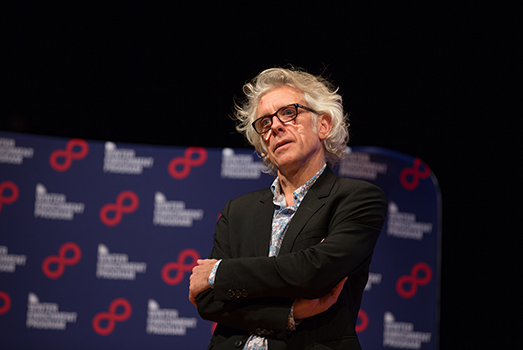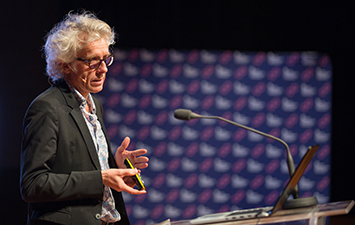Engineering success in pursuit of glory

Dr. Martin Fischer, head of the design team for Groupama Team France—the French challenger—for the 35th America's Cup, speaks during his WEP keynote lecture on January 17. Photo by Lilit Hovhannisyan.
Dr. Martin Fischer, head of the design team for Groupama Team France—French challenger for the 35th America's Cup—spoke to the KAUST community as part of the University's Winter Enrichment Program (WEP) on January 17. Fischer described his work as head of the design team for Groupama Team France and the levels of science, physics, engineering, manpower and skill that go into creating a vessel capable of competing—and hopefully winning—the America's Cup trophy.
"The America's Cup contract or 'Deed of Gift' is one page document, and not many documents survive—especially a contract—for 150 years,” said Fischer. Any yacht club that meets the requirements specified in the Deed of Gift has the right to challenge the yacht club that holds the cup. If the challenging club wins the match, it gains stewardship of the cup.
The event sees two sailing yachts pitted against each other in a set of match races. One yacht known as the defender represents the yacht club currently holding the trophy and the second yacht, the challenger, represents the yacht club challenging for the Cup. The timing of each match is determined by an agreement between the defender and the challenger. The 35th America's Cup will be held in May and June of 2017 in Bermuda.
“The boats are demanding to sail both physically and mentally," Fischer said. "More than 1,000 watts are needed to permanently ensure that the boats' electronics are fully functioning. The boats' power generation comes from humans through physical exertion, and in order to go sailing for one day, you need about 30 people to make this happen.”
Fischer holds a Ph.D. in geophysics and worked for about 10 years in climate research in both Germany and in Italy. In parallel to his climate research work, Fischer also worked on racing sailboat designs, and he has been working on the design of hulls and appendages for numerous projects for 14 years, including beach catamarans (F18, A-Cat, C-Cat) and ocean racing multihulls (Groupama-2/3, Sodebo, Banque Populaire), and was also involved in a Volvo Ocean Race campaign (Groupama-4).
Developing an America's Cup boat is a multidisciplinary effort. Excellence is required in such different fields as aerodynamics, hydrodynamics, structural analysis, advanced composite engineering and building, design of mechanical control systems, hydraulics and electronics and flight control.
“Ten people are needed to launch the boat and six crew members, with other members monitoring the boat, weather and currents. It's challenging to put together such a big team in such a small time period. The boats nowadays look more like airplanes than boats and the day-to-day maintenance on these boats is essential, hence the size of the crew,” Fischer said.

Since automatic control systems (autopilots) are forbidden in the America's Cup rules, there is strong two-way feedback between sailing practicalities and the technological choices being made.
“Fluid dynamics, flight dynamics and structural and mechanical engineering are crucial fields in the boat design. As engineers, we always want to build something that is faster, but the sailing team doesn't want something that they can't handle,” he said.
Fischer described how, in conjunction with the above challenges, the management of a very tight build schedule for hulls, beams, foils, rudders and the wing is essential.
“If you want to design a flying boat, there are two major problems, pitch stability and heave stability. Nowadays everything is specified in what you can build, and there are very few deviations allowed in the boat building process. A good aerodynamic package is crucial—50 percent of drag with the boats is aerodynamic drag. Older boats had a lot more drag than modern boats because of their V hydrofoil configuration. Our team must minimize drag under structural constraints and under cavitation constraints,” he said.
“We cannot build a foil that suits a team today, but we can build a foil we are confident that the sailing team can handle in three to four months when the race is happening. One foil costs €160,000, and for a test boat you can only build six, so you don't want to damage or destroy any," Fischer said. "It is a very complex build process, and this type of testing would be impossible to do manually without computers. It takes about three months build time to build one set of foils.”
Fischer’s lecture showed the sheer scale of human and technological endeavor needed to develop and prepare a boat and crew for the America’s Cup. Fischer and his fellow Groupama Team France members are the perfect example of what is possible when you push the limits of and challenge the fields of engineering and science.
By David Murphy, KAUST News
Dr. Martin Fischer, head of the design team for Groupama Team France—French challenger for the 35th America's Cup—spoke to the KAUST community as part of the University's Winter Enrichment Program (WEP) on January 17. Fischer described his work as head of the design team for Groupama Team France and the levels of science, physics, engineering, manpower and skill that go into creating a vessel capable of competing—and hopefully winning—the America's Cup trophy.
The 'Auld Mug'
The America's Cup, known affectionately as the “Auld Mug,” is the high point of competitive sailing and was first awarded by the Royal Yacht Squadron of Great Britain for a race around the Isle of Wight on August 20, 1851. It became known as the America’s Cup because the first race was won by the schooner America from New York City. The winning schooner America was donated to the New York Yacht Club under the terms of the "Deed of Gift," which made the Cup available for perpetual international competition."The America's Cup contract or 'Deed of Gift' is one page document, and not many documents survive—especially a contract—for 150 years,” said Fischer. Any yacht club that meets the requirements specified in the Deed of Gift has the right to challenge the yacht club that holds the cup. If the challenging club wins the match, it gains stewardship of the cup.
The event sees two sailing yachts pitted against each other in a set of match races. One yacht known as the defender represents the yacht club currently holding the trophy and the second yacht, the challenger, represents the yacht club challenging for the Cup. The timing of each match is determined by an agreement between the defender and the challenger. The 35th America's Cup will be held in May and June of 2017 in Bermuda.
“The boats are demanding to sail both physically and mentally," Fischer said. "More than 1,000 watts are needed to permanently ensure that the boats' electronics are fully functioning. The boats' power generation comes from humans through physical exertion, and in order to go sailing for one day, you need about 30 people to make this happen.”
Technological and human endeavor
Fischer holds a Ph.D. in geophysics and worked for about 10 years in climate research in both Germany and in Italy. In parallel to his climate research work, Fischer also worked on racing sailboat designs, and he has been working on the design of hulls and appendages for numerous projects for 14 years, including beach catamarans (F18, A-Cat, C-Cat) and ocean racing multihulls (Groupama-2/3, Sodebo, Banque Populaire), and was also involved in a Volvo Ocean Race campaign (Groupama-4).Developing an America's Cup boat is a multidisciplinary effort. Excellence is required in such different fields as aerodynamics, hydrodynamics, structural analysis, advanced composite engineering and building, design of mechanical control systems, hydraulics and electronics and flight control.
“Ten people are needed to launch the boat and six crew members, with other members monitoring the boat, weather and currents. It's challenging to put together such a big team in such a small time period. The boats nowadays look more like airplanes than boats and the day-to-day maintenance on these boats is essential, hence the size of the crew,” Fischer said.

Dr. Martin Fischer, head of the design team for Groupama Team France—the French challenger—for the 35th America's Cup, speaks during his WEP keynote lecture on January 17. Photo by Lilit Hovhannisyan.
Winning and losing a competition
“The boats are very complex to design and must be designed in a short period, so our crew is a multidisciplinary team of engineers," Fischer noted. "There is one naval architect on the team and the rest of team come from different areas. Three members of the crew have degrees in engineering. We have three people alone working full time on the aerodynamic aspects of the boat. It's a crucial area that can determine the winning and losing of a competition."Since automatic control systems (autopilots) are forbidden in the America's Cup rules, there is strong two-way feedback between sailing practicalities and the technological choices being made.
“Fluid dynamics, flight dynamics and structural and mechanical engineering are crucial fields in the boat design. As engineers, we always want to build something that is faster, but the sailing team doesn't want something that they can't handle,” he said.
Fischer described how, in conjunction with the above challenges, the management of a very tight build schedule for hulls, beams, foils, rudders and the wing is essential.
“If you want to design a flying boat, there are two major problems, pitch stability and heave stability. Nowadays everything is specified in what you can build, and there are very few deviations allowed in the boat building process. A good aerodynamic package is crucial—50 percent of drag with the boats is aerodynamic drag. Older boats had a lot more drag than modern boats because of their V hydrofoil configuration. Our team must minimize drag under structural constraints and under cavitation constraints,” he said.
“We cannot build a foil that suits a team today, but we can build a foil we are confident that the sailing team can handle in three to four months when the race is happening. One foil costs €160,000, and for a test boat you can only build six, so you don't want to damage or destroy any," Fischer said. "It is a very complex build process, and this type of testing would be impossible to do manually without computers. It takes about three months build time to build one set of foils.”
‘You must respect the limits’
“You must respect the limits, and a very close collaboration must exist between the sailors, engineers and boat builders," Fischer noted. "This collaboration has to be strong—it is crucial. The boats are already extremely physically and very mentally demanding to sail, and as engineers, we don't want to create something that could possibly be deadly. Early on you must decide on the trade-off of stability versus performance goals and you must go close to the edge, but not to go over the edge."Fischer’s lecture showed the sheer scale of human and technological endeavor needed to develop and prepare a boat and crew for the America’s Cup. Fischer and his fellow Groupama Team France members are the perfect example of what is possible when you push the limits of and challenge the fields of engineering and science.
By David Murphy, KAUST News
Related stories
- WEP 2017 kicks off at the Hub
- From Bedouin boy to oil minister
- Hyperloop: From pipe dream to reality
- The right space and time

